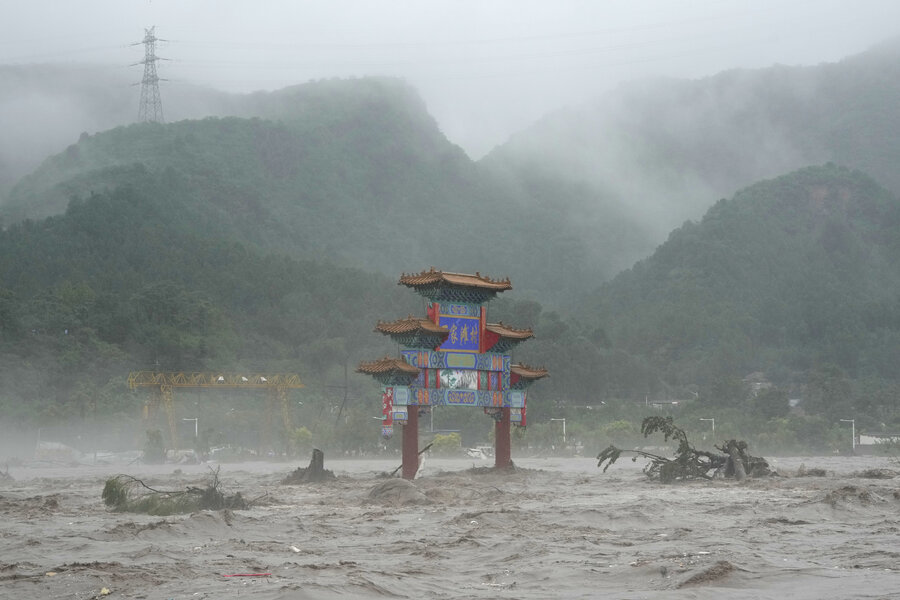Beijing’s worst flood in 50 years: Xi calls for ‘all out’ rescue
Loading...
| Beijing
Beijing and nearby cities stepped up rescue efforts on Tuesday after rains and floods brought by remnants of Typhoon Doksuri disrupted services and food supplies and claimed 20 lives in one of the worst storms to hit northern China in over a decade.
Seasonal flooding hits large parts of China every summer, particularly in the semitropical south, while some northern regions this year have reported the worst floods in 50 years.
Indicating the level of urgency, Leader Xi Jinping issued an order for local governments to go “all out” to rescue those trapped and minimize the loss of life and damage to property.
Beijing’s Fangshan district said it would deploy helicopters to drop off food, drinking water, and emergency supplies to villages in mountainous areas that have been cut off.
In nearby Tianjin, where rain has become intermittent, 35,000 people have been evacuated from their homes, and the local government fortified river banks and stepped up the inspection and repairs of power, water, and communications lines.
Food delivery giant Meituan also added staff and extended delivery times as orders for vegetables, meat, and eggs rose 50% on its app and overall shopping increased by 20%, media reported.
The death toll in Beijing rose to 11 on Tuesday with 13 people still missing. The city government said rainfall over the past few days had surpassed levels seen in July 2012, when Beijing was hit by what was then the strongest storm since the founding of modern China, receiving 190.3mm of rain in one day and affecting more than 1.6 million people.
President Xi Jinping demanded thorough search and rescue efforts for those missing or trapped, instructing authorities to minimize casualties and restore living conditions to normal as soon as possible, state media reported. In Hebei province, nine people died and six were missing.
Tsai Ing-wen, president of democratically governed Taiwan, which China claims as part of its territory, sent condolences, her office said, a show of cross-strait sympathy reserved for major disasters.
China’s finance ministry announced it would allocate 110 million yuan ($15 million) for rescue work in the Beijing-Tianjin-Hebei region.
Doksuri, one of the strongest storms to hit China in years, weakened as it rolled inland and dumped non-stop precipitation in northern cities over a few days. Authorities have warned risks of further floods and other geological disasters remained.
Localized thunderstorms and strong winds were forecast on Tuesday for Beijing, Tianjin, and Hebei, state broadcaster CCTV said, as rainfall stretched into a fourth day.
Rivers have swollen to dangerous levels, prompting Beijing to use a flood storage reservoir for the first time since it was built 25 years ago. As of Monday night, China’s capital city had sealed off over 100 mountain roads and evacuated more than 52,000 people from their homes.
Several subway lines in the capital, including trains in western suburbs, were suspended on Tuesday. Beijing’s Mentougou district in the west saw dramatic damage a day before, after torrential rains turned roads into rivers, sweeping cars away.
Nearly 400 flights were canceled on Tuesday and hundreds were delayed at Beijing’s two airports, tracker app Flight Master showed.
Beijing recorded an average of 260mm (10.2 inches) of rainfall from Saturday to early Monday, with the Changping Wangjiayuan Reservoir logging the largest reading at 738.3mm (29 inches).
In Hebei, precipitation from Saturday to Monday at one local weather station totaled more than the amount normally seen over half a year, with rainfall amounting to 1,003mm (3.3 feet) for the three days. Precipitation in the county where the station is located averages 605mm a year.
Further west in Shanxi, a total of 42,211 people in the province had been relocated as of Monday.
Doksuri swept through coastal Fujian last week, taking a 14.76 billion yuan ($2.06 billion) direct economic toll on the southeastern province and affecting almost 2.7 million people, with close to 562,000 evacuated from homes and more than 18,000 houses destroyed, state media reported.
In early July, at least 15 people were killed by floods in the southwestern region of Chongqing, and about 5,590 people in the far northwestern province of Liaoning had to be evacuated. In the central province of Hubei, rainstorms trapped residents in their vehicles and homes.
China’s deadliest and most destructive floods in recent history were in 1998, when 4,150 people died, most of them along the Yangtze River.
In 2021, more than 300 people died in flooding in the central province of Henan. Record rainfall inundated the provincial capital of Zhengzhou on July 20 that year, turning streets into rushing rivers and flooding at least part of a subway line.
This story was reported by Reuters. Material from The Associated Press was used in this report.







